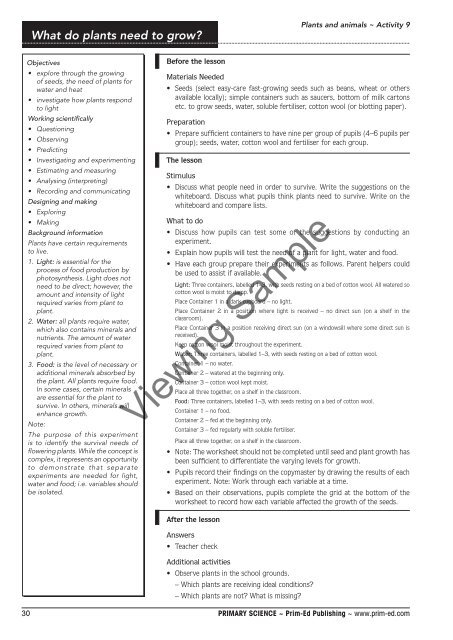PR-0552UK Primary Science - Book 2
Create successful ePaper yourself
Turn your PDF publications into a flip-book with our unique Google optimized e-Paper software.
What do plants need to grow?<br />
Plants and animals ~ Activity 9<br />
Objectives<br />
• explore through the growing<br />
of seeds, the need of plants for<br />
water and heat<br />
• investigate how plants respond<br />
to light<br />
Working scientifically<br />
• Questioning<br />
• Observing<br />
• Predicting<br />
• Investigating and experimenting<br />
• Estimating and measuring<br />
• Analysing (interpreting)<br />
• Recording and communicating<br />
Designing and making<br />
• Exploring<br />
• Making<br />
Background information<br />
Plants have certain requirements<br />
to live.<br />
1. Light: is essential for the<br />
process of food production by<br />
photosynthesis. Light does not<br />
need to be direct; however, the<br />
amount and intensity of light<br />
required varies from plant to<br />
plant.<br />
2. Water: all plants require water,<br />
which also contains minerals and<br />
nutrients. The amount of water<br />
required varies from plant to<br />
plant.<br />
3. Food: is the level of necessary or<br />
additional minerals absorbed by<br />
the plant. All plants require food.<br />
In some cases, certain minerals<br />
are essential for the plant to<br />
survive. In others, minerals will<br />
enhance growth.<br />
Note:<br />
The purpose of this experiment<br />
is to identify the survival needs of<br />
flowering plants. While the concept is<br />
complex, it represents an opportunity<br />
to demonstrate that separate<br />
experiments are needed for light,<br />
water and food; i.e. variables should<br />
be isolated.<br />
Before the lesson<br />
Materials Needed<br />
• Seeds (select easy-care fast-growing seeds such as beans, wheat or others<br />
available locally); simple containers such as saucers, bottom of milk cartons<br />
etc. to grow seeds, water, soluble fertiliser, cotton wool (or blotting paper).<br />
Preparation<br />
• Prepare sufficient containers to have nine per group of pupils (4–6 pupils per<br />
group); seeds, water, cotton wool and fertiliser for each group.<br />
The lesson<br />
Stimulus<br />
• Discuss what people need in order to survive. Write the suggestions on the<br />
whiteboard. Discuss what pupils think plants need to survive. Write on the<br />
whiteboard and compare lists.<br />
What to do<br />
• Discuss how pupils can test some of the suggestions by conducting an<br />
experiment.<br />
• Explain how pupils will test the need of a plant for light, water and food.<br />
• Have each group prepare their experiments as follows. Parent helpers could<br />
be used to assist if available.<br />
Light: Three containers, labelled 1–3, with seeds resting on a bed of cotton wool. All watered so<br />
cotton wool is moist to damp.<br />
Place Container 1 in a dark cupboard – no light.<br />
Place Container 2 in a position where light is received – no direct sun (on a shelf in the<br />
classroom).<br />
Place Container 3 in a position receiving direct sun (on a windowsill where some direct sun is<br />
received).<br />
Keep cotton wool moist throughout the experiment.<br />
Water: Three containers, labelled 1–3, with seeds resting on a bed of cotton wool.<br />
Container 1 – no water.<br />
Container 2 – watered at the beginning only.<br />
Container 3 – cotton wool kept moist.<br />
Place all three together, on a shelf in the classroom.<br />
Food: Three containers, labelled 1–3, with seeds resting on a bed of cotton wool.<br />
Container 1 – no food.<br />
Container 2 – fed at the beginning only.<br />
Container 3 – fed regularly with soluble fertiliser.<br />
Place all three together, on a shelf in the classroom.<br />
• Note: The worksheet should not be completed until seed and plant growth has<br />
been sufficient to differentiate the varying levels for growth.<br />
• Pupils record their findings on the copymaster by drawing the results of each<br />
experiment. Note: Work through each variable at a time.<br />
• Based on their observations, pupils complete the grid at the bottom of the<br />
worksheet to record how each variable affected the growth of the seeds.<br />
Viewing Sample<br />
After the lesson<br />
Answers<br />
• Teacher check<br />
Additional activities<br />
• Observe plants in the school grounds.<br />
– Which plants are receiving ideal conditions?<br />
– Which plants are not? What is missing?<br />
30 <strong>PR</strong>IMARY SCIENCE ~ Prim-Ed Publishing ~ www.prim-ed.com


















